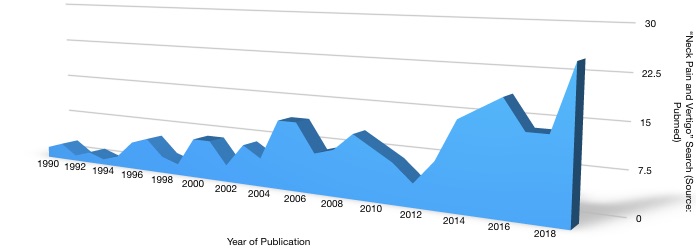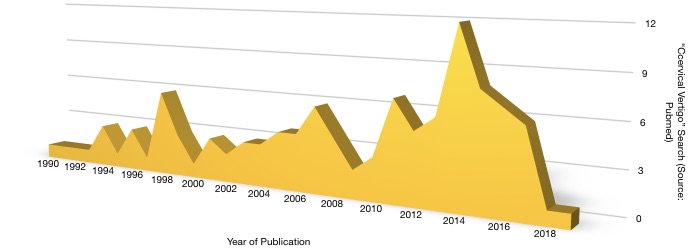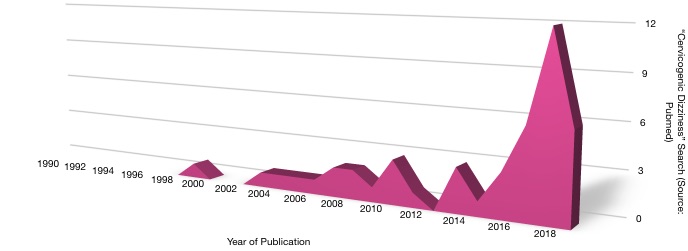Science begets more science.
That is how we continue to advance and propel ourselves forward in neuromusculoskeletal rehabilitation.
For over the past decade, we have treated dizzy/vertigo and neck pain disorders. We have allowed guidelines and clinical expertise guide us to treat these conditions when presented to us independently. More memorable to us is what we have created together (orthopedic and vestibular therapist) when these symptoms are combined or overlap. We call this our Physio Blend.
Most clinicians can agree that these symptoms are combined more often than simply independent entities but difficult to “prove” via research. During our teaching, we discuss the research on the double entity — i.e. multiple systems contributing to symptoms — but today, we present to you 5 charts showing why neck pain and dizziness are correlated in research.
1. Concussion Research

Concussion, in general, has by far had the greatest attention in the medical industry in the past few years. As you can even see from the graph above, a huge spike starting occurring around 2012 and has skyrocketed over 300%. For those in the clinic treating Post-Concussion Syndrome, you are well aware of the multiple systems (and professionals) needed to treat the individual entirely. Read more about this topic from a previous post here and here.
2. “Neck Pain and Dizziness” Research

When I searched for the combined phrase, “Neck Pain and Dizziness”, I did not expect to find such a spike in research over the past several years. Obviously this does make sense clinically as this is what we see (and teach), but good to see the research catching up. For you all in the clinic, I know you see an improvement in neck pain patients when treating the neck and could also see a spike in improvements with neck pain when treating the vestibular system. Read more about this topic from a previous post here and here.
3. “Neck Pain and Vertigo” Research

Vertigo as a symptom is not nearly as correlated clinically as dizziness as a symptom when speaking of Cervicogenic Dizziness, but can’t deny the overlap of terms in the clinic and research. Interesting there is a big spike from 2017 to 2019 with articles (almost double) with this phrase. We have written about the controversy between professions over this topic and you can read more about it here.
4. Cervical Vertigo Research

Cervical Vertigo should be becoming more antiquated of a term and you can certainly see a drop in this phrase in the research starting in 2014. One of our most popular articles discusses this topic and you can read more about it here.
5. Cervicogenic Dizziness Research

You may wonder why we actually left the phrase, “Cervicogenic Dizziness” for last in this article considering this is the main expression or our combined knowledge. You can see from the chart above that this is the least common terminology and nothing was found of it prior to the year 2000 when Diane Wrisley’s most famous article came out. I think you can take out of this chart is that if you want to research an article, you need to look at multiple search items and not limit yourself to one phrase. This is how we created the research behind our Physio Blend — by examining the works of the osteopaths, acupuncturists, chiropractors, physios and surgeons. We really need to favor conservative care for this condition and you can read more about this topic here.
So there you go! You can see a trend towards having knowledge of multiple systems to fully treat someone with dizziness, vertigo and neck pain.
You can learn more about the screening and treatment process of Cervicogenic Dizzinesss through Integrative Clinical Concepts, where the author and his wife, a Vestibular Specialist, teach a 2-day course. Pertinent to this blog post, the first day provides the most up-to-date evidence review from multiple disciplines to diagnose through the “Optimal Sequence Algorithm” to assist in ruling out disorders and ruling in cervical spine, including determining if single or double entity exists.
If you would like to host a course for your staff (either a vestibular, neuro, sports or ortho clinic), please do not hesitate to contact me at harrisonvaughanpt@gmail.com for prices and discounts.
Sign up for more emails on this topic by clicking here
reposted with permission from In Touch PT Blog
Authors
Harrison N. Vaughan, PT, DPT, OCS, Dip. Osteopracic, FAAOMPT
Instructor: Cervicogenic Dizziness for Integrative Clinical Concepts
Danielle N. Vaughan, PT, DPT, Vestibular Specialist
Instructor: Cervicogenic Dizziness for Integrative Clinical Concepts
- NEW - Online Discussion Group
- Live cases
- webinars
- lecture
- Live Q&A
- over 600 videos - hundreds of techniques and more!
- Check out MMT Insiders
















Post a Comment
Post a Comment